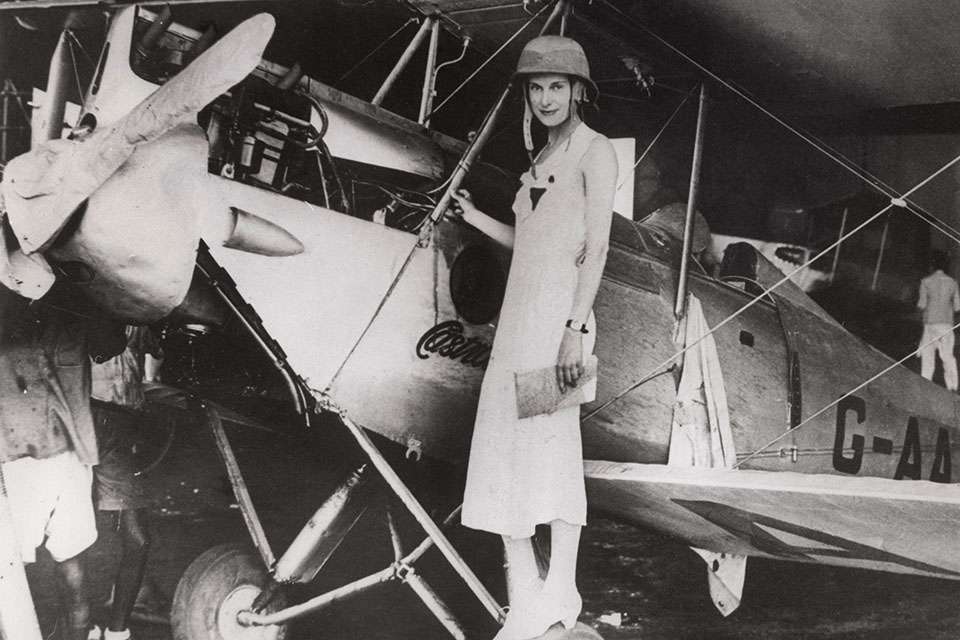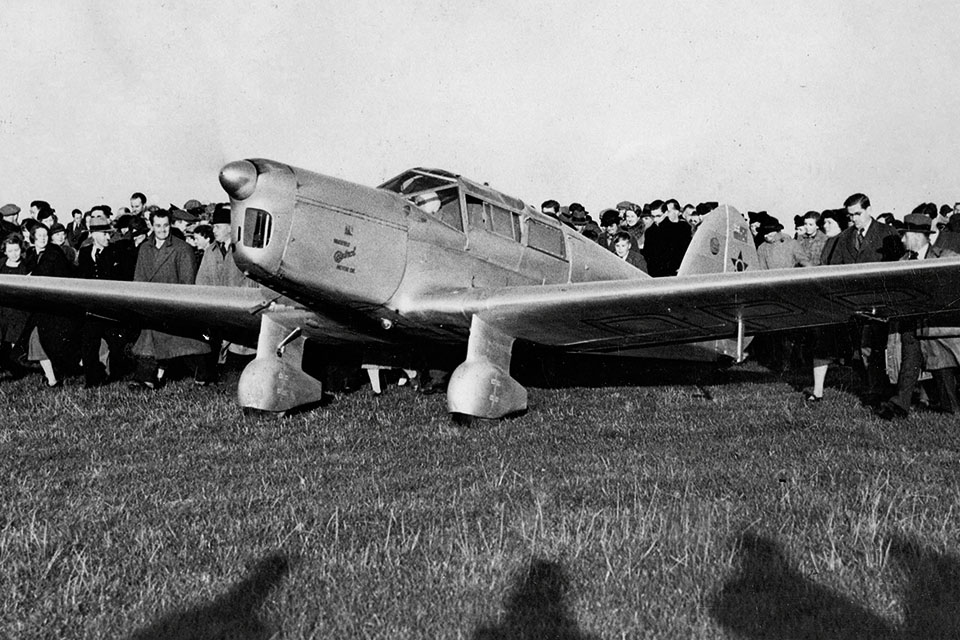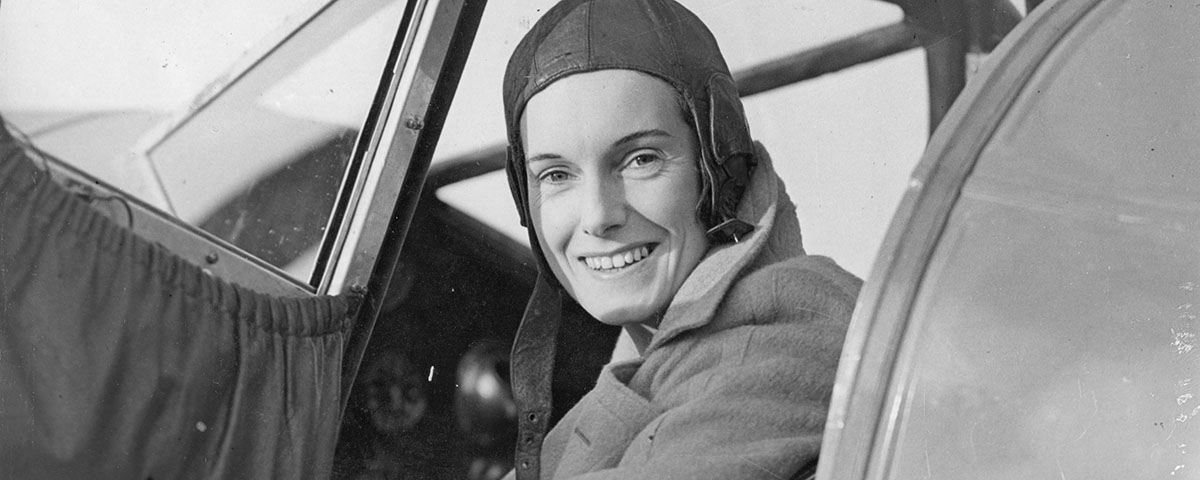For her 26th birthday on September 15, 1935, Jean Batten treated herself to a brand-new Percival D.3 Gull Six. The low-wing Gull had a 200-hp Gipsy 6-cylinder engine and auxiliary fuel tanks, giving it a cruising speed of 150 mph and a range of 2,000 miles. It cost Batten £1,750, “every penny I owned,” she said.
Just two months later Batten was in the Senegalese town of Thies, preparing for an ambitious solo flight across the South Atlantic to Natal, Brazil. The flier, who had already set several long-distance records, made meticulous preparations for her newest venture. A stylish woman who wanted to look her best at VIP events, she was all business when it came to aircraft maintenance. At Thies she insisted on working on the Gull’s engine herself and on supervising the fueling process. Despite muttering from the French air force mechanics looking on, she made sure the fuel was carefully filtered through a chamois cloth to remove impurities.
Next Batten sorted out her flying kit, discarding heavy items such as spare engine parts, a tool box, a flare pistol and water drums. But as a bemused French commandant looked on, the flier carefully refolded two evening dresses and stowed them away in her locker. Later asked why she had made such a feminine choice, Jean’s answer was matter-of-fact. The dresses weighed almost nothing, she pointed out. If her flight was successful, she would need them. And if she ended up in the Atlantic, the heavy equipment would be of no use.
As it turned out, the New Zealander did need her evening wear. But several times during her journey through heavy weather she wished she had been able to afford a radio to help with navigation. Ultimately, though, her calculations enabled her to reach South America without any trouble. With an overwater flight lasting 13 hours and 15 minutes, Batten had beat Australian Jim Mollison’s time across the South Atlantic by more than four hours. Her total elapsed time from England to Brazil—a 5,000-mile trip—was 61 hours and 15 minutes, a world record, and almost a day less than Mollison’s England-Brazil record. After landing near Natal, Batten exulted, “I experienced once again the greatest and most lasting of joys—the joy of achievement.”
That same exhilaration had drawn Batten to the skies ever since her first flight, with pioneering Australian aviator Sir Charles Kingsford-Smith in his Fokker F.VII/3m Southern Cross. Sir Charles, who became the first to fly across the Pacific from America, gave Batten two pieces of advice—both of which she would ignore: “Don’t attempt to break men’s records, and don’t fly at night.”
Jane Gardner Batten, who preferred to be called Jean, was born in Rotorua, on New Zealand’s North Island, the daughter of Captain Frederick H. Batten, a dentist, and the former Ellen “Nellie” Blackmore. Just before Jean’s birth, Louis Blériot had become the first man to fly across the English Channel. Ellen clipped a newspaper article about Blériot’s feat and pinned it to the wall next to her baby’s cot. Whether it made a difference in her daughter’s ambitions no one can say. But Ellen clearly succeeded in instilling in Jean the idea, radical at the time, that she must be prepared to compete with men.
The family moved from Rotorua to Auckland when Jean was 4. Early on she was passionate about books and music, and her father encouraged her to become a concert pianist. She attended the Ladies College in Remuera, studying music in Auckland. Around that same time, her parents separated.
Batten read about Australian Bert Hinkler’s groundbreaking solo flight from England to Australia in February 1928, and was also inspired by the journey from San Francisco to Brisbane made three months later by Kingsford-Smith, Australian Charles Ulm and Americans James Warner and Harry Lyon. “I was deeply interested in these two flights,” Jean wrote, “and when later Charles Kingsford-Smith flew over the Tasman Sea to New Zealand, my enthusiasm for aviation increased and I decided to become a pilot.” After her flight with Kingsford-Smith during a visit to Australia in 1929, she recalled, “Cruising high above the Blue Mountains, I had felt completely at home in the air and decided that here indeed was my element.”
Her father was apprehensive, telling her of the many crackups he had witnessed during World War I and warning that flying lessons were expensive. But her mother became her most enthusiastic supporter. Jean sold her piano to raise funds for her new venture, and Ellen agreed to accompany her to England—ostensibly to continue music studies. Traveling to London in 1930, mother and daughter initially stayed with Jean’s brother John. Jean discovered the London Aero Club, based at the nearby Stag Lane airfield, the home field of celebrated British flier Amy Johnson. The young New Zealander applied herself to the grubby business of learning about aircraft engines, airframes and aeronautics. It didn’t come easy, as she was “far from being a natural pilot” at the start, according to a colleague. Once while soloing in one of the Aero Club’s de Havilland Gipsy Moths, Batten overshot the field, hit a wire fence and overturned. Though she emerged unhurt, her confidence was shaken. But she wasn’t a quitter. Inspired by Johnson’s example, she managed to earn her pilot’s “A” license in 1930.
Batten then returned home, where she struggled to obtain financial backing for a flight from England to Australia. Initially no one offered any help, but at length her brother John paid her passage back to England. Then one of the many young men interested in her, Royal New Zealand Air Force pilot Fred Truman, gave her £500, his bonus after five years in the military. If Truman hoped to foster a romantic relationship with the attractive aviatrix, he was sadly mistaken. As author Ian Mackersey pointedly noted in his 1990 biography Jean Batten: The Garbo of the Skies, Batten “totally ignored him in her two published books and her unpublished memoirs….Yet without doubt she owed her subsequent success more directly to Fred Truman than to any other person.”
Jean went back to work at Stag Lane to learn more about aircraft maintenance, as well as navigation and meteorology. She piled up flying hours, and in December 1932 gained her “B” commercial license—just a few days before Amy Johnson set a Cape Town– to–London solo record. She also met Victor Dorée, the son of a prosperous English linen merchant, who agreed to help underwrite her solo flight to Australia. In her book My Life, Batten explained, “I was to have a half-share in a second-hand Moth and, in return, signed an agreement to give the other pilot fifty per cent of any proceeds from that flight and to tour Australia and New Zealand for twelve months giving passenger flights.”
In April 1933, wearing a New Zealand flag around her neck, Batten clambered into the cramped cockpit of a Gipsy Moth 60 at Kent’s Lympne airfield and took off. Christened Jason, her plane had originally been owned by the Prince of Wales.
Bad luck lay ahead. Batten was forced down by a sandstorm in Baluchistan, India (now Pakistan), and damaged her propeller during a blind landing. After obtaining a replacement prop, she set out once again, but after flying just 70 miles, the Moth’s engine gave out. “A connecting rod broke and went bang through the side of the crankcase,” Batten reported. She made a dead-stick landing on a roadway outside Karachi, plowing into a stone marker. The damage done spelled a premature end for that attempt.
A year later Batten again attempted to fly to Australia, but misfortune still dogged her. Following a more southerly route than Johnson had taken, the New Zealander headed southward across France, then turned from Marseille toward Rome. Headwinds slowed her down, and she ran out of fuel, as she later recalled, “at midnight in teeming rain and pitch darkness over the Italian capital.” She managed to steer her Moth to a landing on a small field on Rome’s outskirts, emerging with minor injuries. But the Moth was seriously damaged. Returning to London to plot yet another attempt, she learned that her abortive flights had made news, but not in a good way. The Fleet Street dailies were poking fun at her: “Try Again, Jean,” read one headline.

She needed no prodding. Less than a month later Batten readied her patched-up Moth for a third solo attempt to Australia. Because her Rome mishap had delayed her, she took off at a time—mid-May—when monsoons usually threatened Southeast Asia. Yet despite a serious oil leak that grounded her aircraft for repairs in Calcutta, much of Batten’s third attempt turned out to be a smooth sightseeing tour.
However, one leg of her journey—from Rangoon to Victoria Point, on Burma’s southern tip—turned into a nightmare. After Batten took off into an overcast sky in sultry temperatures, she ran into severe squalls, and five hours out of Rangoon she found herself surrounded by a huge storm. There was no way around it, and her fuel supply was too low for her to turn back. “The rain thundered down on to the wings of my airplane like millions of tiny pellets,” she reported, “and visibility was so bad that the wingtips were not visible and the coastline was completely blotted out.”
Batten doggedly steered through the storm as her engine sputtered along, the open cockpit nearly flooded. Suddenly, through a freakish break in the storm, she caught a glimpse of the jungle beneath her. She dived under a curtain of black clouds and flew back and forth for 35 anxious minutes, searching for a place to put down. Providentially, Batten spotted a clearing that proved to be the landing field at Victoria Point. The worst part of her journey was over. On May 23, 1934—less than 15 days after leaving England—she touched down triumphantly on the airfield at Darwin, Australia, having beaten Amy Johnson’s time by more than four days.
The Australians welcomed Batten as enthusiastically as they had greeted Johnson. The Kiwi pilot soon paid a visit to her homeland, crossing the Tasman Sea by ship because her Moth lacked the range to traverse its 1,200-mile-wide expanse. The usually reticent New Zealanders cheered her wherever she went. Crowds packed the streets of Auckland, resulting in huge traffic jams. The government gave her $3,000, and she was the guest of honor at a celebration staged by the Maoris. Presented with a tribal chief’s feather cloak, she was christened Hine-o-te-Rangi (Daughter of the Skies).
For six weeks, while her Moth was being overhauled, New Zealand’s favorite daughter toured her homeland, giving speeches and reveling in all the adulation. But for her mother, back in England, the constant harassment by the press during Jean’s ordeal had been sheer torture, and she would not soon recover. As the Daily Express reported, the “iron-nerved, silver-haired Mrs. Batten crumpled up. She went flying off to the country away from the glamour of her daughter’s achievement.”
When Batten took off on her return flight, she told the Darwin station commander: “If I go down in the sea, no one must fly out to look for me. I have no wish to imperil the lives of others.” Over the Timor Sea, about 250 miles out of Darwin, the Moth’s engine coughed, faltered and then subsided into silence. As her biplane began a slow, inexorable glide down toward the waves, Batten prayed the problem was just a temporary fuel line blockage. She gave the engine full throttle, but there was no response.
She watched helplessly as the altimeter needle spun from 6,000 feet down to 3,000 feet. At last it seemed there was only one thing to do—ditch. She unfastened her shoes and flying suit, and reached for her small emergency hatchet. If she managed to set the plane down on an even keel, she reasoned, she might be able to hack off a wing and float on it. Miraculously, just as the Moth was about to hit the water, its engine burst to life again. Batten climbed back up to 6,000 feet, holding that altitude until she spotted Kupang, on Timor, then circled down to land.
The rest of the trip was nerve-wracking, with the Moth’s engine sputtering, stopping and restarting several more times before she reached Croydon. Batten had completed the return journey from Darwin in 17 days and 15 hours—the first woman to do so. She once again relished the limelight, but was surprised to find that the London dailies made as much of her flying attire as her feat: She was wearing trousers.
Batten soon started planning new record-breaking flights. In 1935 she made her flight from West Africa to Brazil, becoming the first woman to fly solo across the South Atlantic. She continued building her reputation as a pathfinder in her Percival Gull. By this time she was the most celebrated New Zealander of the decade, receiving trophies from British, American, French, Swedish, Danish, Belgian and Brazilian aeronautical societies. In 1936 she was made a Commander of the British Empire, and she won the Harmon Trophy three times, sharing the first with Amelia Earhart. She was also awarded Brazil’s Order of the Southern Cross, and made a chevalier of the French Legion of Honor.
In 1936 Batten vowed to fulfill “the ultimate of my ambition” and prove the practicability of an England–to–New Zealand air route. That October she climbed into her Gull and took off from Lympne, bound for Auckland. She arrived there 11 days and 45 minutes later, establishing a solo record of five days, 21 hours, from England to Australia, and a record Tasman Sea solo crossing of nine hours and 15 minutes. Her overall time included a weather delay of 2½ days in Sydney, where she was cheered by thousands. For the first time, England had been linked directly with New Zealand. On her return flight in October 1937, she established a solo record from Australia of five days, 19 hours and 15 minutes.

Batten’s many long-distance flights were characterized by brilliant navigation precision, achieved by use of only a map, watch and simple magnetic compass. But while her feats ranked with those of Johnson and Earhart, she has remained the least well known of the three. That was because of the wall that Batten and her fiercely protective mother built around themselves in the aftermath of her sudden fame. The media dubbed Jean the “Greta Garbo of the air” because—like the famously reclusive actress—she was a beautiful woman who was intensely private. She was frequently compared unfavorably with the popular Johnson.
Batten was also criticized for commercializing her own image, but—like Earhart—she found it necessary to capitalize on her fame to fund her record attempts, endorsing a variety of products, including Castrol oil. She also embarked on lecture tours, collected fees from the Gaumont film company and the London Daily Express, contributed narration to an RAF recruiting film and became involved in writing and broadcasting about aviation. The two books she wrote about her own career, My Life (1938) and Alone in the Sky (1979), would receive generally poor reviews.
As war clouds loomed in 1938, Batten began a tour of England and Europe, hobnobbing with VIPs. She returned to Britain the following year, and when World War II broke out promptly applied to join Captain Pauline Gower’s Air Transport Auxiliary, a volunteer organization of women ferry pilots. Strangely, Batten was rejected, perhaps because of her double vision—the result of an early crash—or maybe because she was not seen as a team player.
Instead she became a driver for the Anglo-French Ambulance Corps, serving in France during the “Phony War” of 1939-40. She spent the rest of WWII on a war bond tour of Britain. Her Percival Gull was commissioned for active service, though Batten herself never again entered the cockpit.
After WWII ended, the New Zealander fashioned a self-contained existence for herself with her mother—in Jamaica, on an extended tour of Europe and also at Tenerife, in the Canary Islands. During the 1970s, not long after Ellen’s death, Jean threw herself into a brief round of public appearances commemorating the heady era of long-distance flying. She visited New Zealand in 1977, when she was the guest of honor at the dedication of the Aviation Pioneers Pavilion at Auckland’s Museum of Transport and Technology.
Batten’s solo England–to–New Zealand record stood for 44 years. When Judith Chisholm of Britain landed her Cessna Turbo Centurion at Auckland in 1980, after flying for three days and 11 hours, among those who greeted her was Batten, who had made her own epochal flight 16 years before Chisholm was born.
The reclusive celebrity rented a small apartment in the Spanish port of Palma de Majorca in 1982, but her life there ended all too soon. On November 22, a cleaning woman discovered Batten’s lifeless body in her apartment. She had died at age 73 from a pulmonary abscess—the result of an untreated dog bite.
When an attempt to locate relatives or friends failed, Batten was buried in the Palma Cemetery in January 1983. Although she left an estate amounting to about £100,000, her remains were laid in an unmarked paupers’ grave together with those of 150 others.

It would take detective work by Batten’s surviving family and her biographer to find out just what had happened. Not until 1987 did Jean’s nephew, Rick Batten, receive his aunt’s death certificate, with no explanation of the circumstances. Around that same time, however, Jean’s papers in Majorca were unearthed, and Ian Mackersey notified Television New Zealand of Batten’s death five years earlier. Headlines in one newspaper heralded “The Final Loneliness of the Long-Distance Aviator.”
Batten’s modified Gull was eventually acquired by Britain’s Shuttleworth Collection, which sold it to the Auckland Airport in the 1990s. To mark the 60th anniversary of Jean’s flight from England to New Zealand, Cherie Marshall flew the Gull over Auckland on November 4, 1996. When its engine started running rough, Marshall put out a mayday call, but she managed to land safely. Following that flight, the Gull was suspended inside the airport’s Jean Batten International Terminal, where it can still be seen today.
Mackersey’s 1990 book drew on memoirs found after Batten’s death and hundreds of interviews. As he summed it up, his biography paints a portrait of “a fascinating woman who combined bravery and ruthlessness with the stunning and seductive beauty she used so effectively to fulfill her great ambitions.” Today much of the world has forgotten the audacious Kiwi pilot who pitted herself against the most famous fliers of her day. But New Zealand still remembers its Daughter of the Skies.
Longtime contributor Michael D. Hull writes from Enfield, Conn. Additional reading: Jean Batten: The Garbo of the Skies, by Ian Mackersey; and My Life, by Jean Batten.
Originally published in the March 2015 issue of Aviation History. To subscribe, click here.





